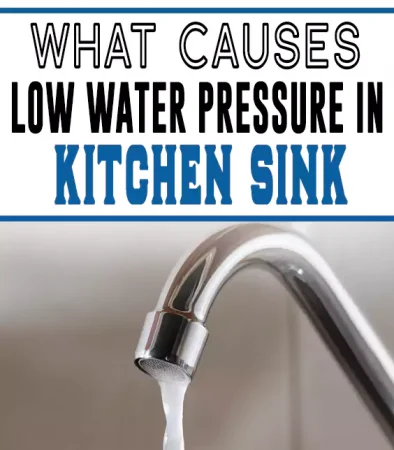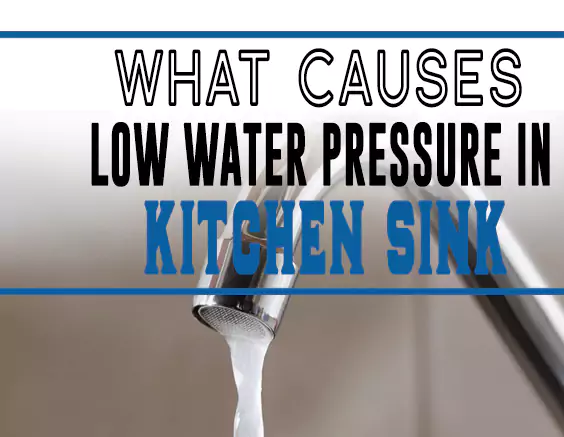You have probably had to deal with a lack of water pressure a couple of times, but what causes low water pressure in kitchen sink?
Everyone hates dealing with it, especially in kitchen sinks, as you need high pressure for a lot of work there.
This makes tons of people wonder what causes low pressure in kitchen sinks. And although there can be many reasons for low water pressure, the most common ones might just be a clogged pipe system, aerators, and cartridges. The aerator is the tip of the faucet, and the cartridge allows you to stop and start the water flow.
Since these are the most critical parts of a faucet, they can easily get clogged up. There’s much more to it than that, though. So in this article, I’ll be going all over low-pressure kitchen sinks, how to fix them, and much more.

Causes of Low Water Pressure in Kitchen Sink;
If you notice low water pressure out of your kitchen faucet, you should first check how many sinks it affects. This is because when all sinks are affected by low water pressure, it is likely due to the water line or water heater.
But other than that, the most common reason is clogged faucet parts from mineral deposits or dirt and grime accumulating in the faucet itself. Here’s a quick list of all the reasons you could have low water pressure in the kitchen sink—
1. Blocked Supply Line
Most of the time, low pressure is caused when your water supply line is blocked. This won’t only apply to your kitchen faucet but to all other water sources of your house too. They can easily get blocked if they get clogged, so you should hire an experienced plumber for them.
2. Faulty Faucet
If you bought your kitchen faucet off for a really low price, they’d often give you rusted or faulty faucet cartridges and aerators. This can lead to the pressure being much lower, and you can just fix this by getting a high-end kitchen faucet.
3. Clogged Aerator
Since the aerator covers the end spot of the faucet where the water actually comes out, the pressure and pattern of the water flow entirely depend on it if you have a properly functioning faucet. So make sure your aerator isn’t clogged by mineral deposits or rust.
If this is the case, you can simply replace the aerator, but cleaning it might be easier if you don’t have much rust on it. You can clean it by using some vinegar and soap.
4. Clogged Cartridge
The faucet cartridge is the next most important part of a faucet after the aerator when it comes to water pressure. It’s the part that controls the opening valve and lets the water through your pipes from the faucet handle. But you can easily have a clogged cartridge from hard water stains or mineral deposits.
If this is the case, we would highly recommend you hire a professional instead of trying to clean it yourself, as it’s more complicated to clean than the other parts.
5. Faulty Handle
If you have an old or cheap faucet handle, it might not correctly move the faucet cartridge to start the flow of water. And even though a faulty handle is usually not found in any kitchen faucets of our age, it’s still worth checking.
6. Faulty Pressure Reducing Valve
The pressure-reducing valve controls the water pressure from the municipal supply. The exact location may vary in different areas, but it’s always placed around the incoming water line.
You can locate it quite easily as it has a bell-shaped top. To fix the low pressure, simply loosen the screws on top of it to adjust the water pressure from the valve.
7. Clogged Water Heater
If you have a water heater in your house for heating up your kitchen faucet water, it can reduce the pressure for both hot and cold water. This is because the water heater can build up a lot of sediments.
You can easily prevent this by flushing the water heater every 6 months. But if you already have sediments in the water heater, you’ll have to hire an expert to clean it for you.
8. Pipe Leaks
If you have a leak somewhere in your water line, it may disrupt the speed and flow of the water leading to a lower water pressure through your kitchen faucet.
These leaks can occur almost anywhere on the pipes and are difficult to locate. So having a professional check would be the best option if none of the options above fixed the low water pressure.
In the worst-case scenario, these leaks might happen on the pipes inside your walls. So we highly recommend getting checked for leaks as fast as possible.
Why is The Water Pressure Low in Only One Sink in The House?
Most of the time, low water pressure in the kitchen sink is caused when you have issues in the water line itself, such as clogged up pipes or leaks. Your water heater can also cause it, but all of these causes target every sink in your house, not just one.
So if you just have low water pressure in only one sink, it’s definitely caused by clogged aerators or cartridges. To fix these, you could simply just clean the two parts, but that’s easier said than done. We’d recommend you get a specialist to clean them for you to have the best water pressure possible.
But in some very rare cases, you could have just the sink’s pipe clogged or leaked. These are incredibly hard to identify, so we recommend you check the faucet’s water pipes with low water pressure by a plumber.
Hot Water Pressure Low But Cold One is Fine: Reasons and solutions
If your hot water pressure is low but cold fine, it’s most likely an issue with your water heater. Most of the time when you have an issue with low water pressure, it affects every hot water faucet in your house.
But sediment buildup on your water heater can cause the heater’s capacity to decrease, resulting in lower water pressure. This is why the hot water pressure might be lower than the cold water pressure. Since the cold water can come straight from the water line instead of getting heated.
Thankfully, you can easily fix most issues regarding your water heater by simply getting a professional to clean it and flushing it every 6 months or so. And unless you have a really old faulty heater, a simple cleaning job can make it heat water just as fast as before.
Why You May Experience Low Water Pressure in Kitchen Sink After Replacing Water Heater?
Even after getting your water heater cleaned or replaced, many people still have low water pressure and ask “why is there low water pressure after installing the water heater”. Although there can be many reasons for it, it’s likely because the low pressure isn’t from your water heater but rather from other sources.
These can range all the way from issues with the water line to the faucet itself, so you can’t really tell where the problem exactly is without checking everything first. But you should always check the aerators and cartridges of your faucet, to begin with, as these are the most common reasons.
Other than that you can check your water lines by hiring an expert, and this should fix your issue if the hot water pressure is lower than cold after replacing the water heater.
Does Water Heater Affect Water Pressure?
Many people think the only way all your faucets can have low water pressure is through issues with the water line, but that’s actually not the case. The water heater itself can cause you to have low pressure.
This is because a lot of the time, sediments build up inside the water heater causing it to be clogged up or slow. As this reduces the ability for it to send the heated water through your pipes, you may experience low water pressure in the kitchen sink.
You don’t have to worry much about this, though, as you can prevent it by flushing the water heater every 6 months.
Why is Hot Water Barely Coming Out of The Faucet?
There can be many reasons why hot water is barely coming out of the faucet. But the most common one would be if you have a faulty heater, water valve, or clogged aerators, cartridges, and pipes.
These can cause your water to flow much slower both into the faucet and out of the faucet. So if you can fix these with the help of a technician and maintain them relatively often, you can easily avoid having low hot water pressure. A rusty faucet can also change the water pressure, so change any old kitchen faucets you have.
How to Increase Hot Water Pressure Kitchen Sink?
Other than fixing low water pressure issues, you can actually increase the water pressure of your kitchen sink even further. Here are a few ways how:
1. Call Your Local Water Department
If you want to check whether you’re getting the right water pressure, you should call your local water department. Most of the time, they’ll run a pressure test on the pipes of your home often free of cost and increase low water pressures.
2. Adjust Your PRV
By adjusting the PRV or pressure-reducing valve, you can increase the water pressure. Don’t let the name confuse you, though, as it doesn’t decrease your water pressure but rather keeps it in control.
By twisting it clockwise, you can increase the water temperature after using a pressure gauge.
3. Install Pressure Boosters
If you’ve tried all the methods above and still aren’t getting satisfactory water pressure, you might want to consider getting a pressure booster. With the help of a plumber, you can install these electric pumps on the water supply line and raise the water pressure.
Wrap Up
Hopefully, now you have a good idea of what causes low pressure in kitchen sinks. It’s usually because of your faucet aerator or cartridge, clogged pipes, leaks, and sedimented heaters. You can easily avoid and fix all of these problems, though.
But as a final note, we highly recommend you to change your faucets’ aerator every now and then, especially when it gets rusted. A lot of the time, cleaning them for a long time with tons of soap won’t even get them fully cleaned, and over time you’ll get a lower and lower water pressure.
Changing your entire faucet would be expensive, but changing just the aerator actually wouldn’t, so it’s definitely worth it. But with all that being said, cheers!

